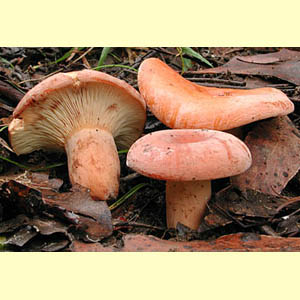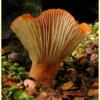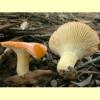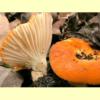
images/Lactarius_clarkeae_group/Lactarius_clarkeae.jpg
Medium to large agaric, growing on the ground, with white spore print. Pileus bright orange, rarely pale, brown or red or pink, not viscid. Lamellae adnexed, adnate or subdecurrent. Stipe central, flesh chalky in texture. Partial veil remnants absent. Latex present or absent (even in fresh material). Spores hyaline, amyloid, warty or reticulate; germ pore absent. Cheilocystidia present. Lamellar trama interwoven; sphaerocytes present. Pileipellis a trichoderm, consisting of narrow, thick-walled elements. Clamp connections absent.
Similar in appearance to
Lactarius and
Russula, but differing from most species of those genera by the strong orange colour of the pileus and the thick-walled terminal elements of the pileipellis. The species placed in
Lactarius (
L. clarkeae and
L. subclarkeae) differ from other members of that genus by not always producing latex and by the presence of sphaerocytes in the lamellar trama.
Three species:
Lactarius clarkeae,
Russula flocktoniae and
L. subclarkeae. Keyed out separately from other
Lactarius due to the similarity in overall apperance and the distinctive pileipellis structure. In addition,
L. clarkeae is unusual in
Lactarius in having sphaeroctyes in the lamellar trama, and often latex is not evident.
See the section on Taxon circumscription for discussion of why this mix of species from Lactarius and Russula are grouped together.
Lactarius clarkeae Cleland,
Trans. & Proc. Roy. Soc. S. Australia 51: 302 (1927).
W.A., S.A., Qld, N.S.W., Vic. and Tas. (and probably also N.T.).
In native forests.
On the ground.
Ectomycorrhizal.
Bougher, N.L. (2009a),
Fungi of the Perth region and beyond: a self-managed field book, Western Australian Naturalists' Club (Inc.), Perth. [
Description and
Illustration of
R. flocktoniae]
Bougher, N.L. & Syme, K. (1998), Fungi of Southern Australia. University of Western Australia Press, Nedlands. [Description, Illustration and Microcharacters of L. clarkeae and R. flocktoniae]
Fuhrer, B. (2005), A Field Guide to Australian Fungi. Bloomings Books, Hawthorn. [Description and Illustration of L. clarkeae and R. flocktoniae]
Grgurinovic, C.A. (1997a), Larger Fungi of South Australia. The Botanic Gardens of Adelaide and State Herbarium and The Flora and Fauna of South Australia Handbooks Committee, Adelaide. [Description and Microcharacters of L. clarkeae, L. subclarkeae and R. flocktoniae, and Illustration of the latter]
McNabb, R.F.R. (1971), The Russulaceae of New Zealand. 1. Lactarius DC ex S.F.Gray, New Zealand J. Bot. 9: 46–66. [Description and Microcharacters of L. clarkeae from New Zealand]
Taylor, M. (1981), Mushrooms and Toadstools. A.H. & A.W. Reid, Wellington. [Illustration of L. clarkeae from New Zealand]
Verbeken, A., Nuytinck, J. & Stubbe, D. (2010), Type studies of six Australian and one New Zealand Lactarius species (Basidiomycota, Russulaceae), Cryptog. Mycol. 31: 235–249. [Microcharacters of L. clarkeae and L. subclarkeae]
Young, A.M. (2005b), A Field Guide to the Fungi of Australia. University of New South Wales Press, Sydney. [Description and B&W Illustration of L. clarkeae]





